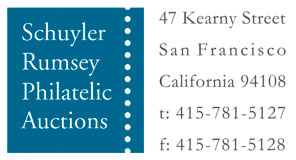
Lot
1138 
Confederacy, Charleston, S.C., 1861, 5¢ blue, margins large to just in at lower right and top, tied by neat strike of "Charleston, S.C., Oct 11, 1861" cds on cover to Camden, S.C., with red "Office of the Fire Alarm and Police Telegraph, Main Guard House, Charleston, S.C." imprint; cover with expertly restoration mostly along top edge, Very Fine appearance, illustrated in Calhoun book (page 76). Scott No. 16X1 Estimate $4,000 - 6,000.
A WONDERFUL CHARLESTON POSTMASTER'S PROVISIONAL USAGE ON COVER WITH A FIRE ALARM AND POLICE TELEGRAPH IMPRINT.
The Fire Alarm and Police Telegraph system was installed in Charleston by John Nelson Gamewell, a Camden S.C. postmaster and telegraph operator who purchased rights to the system in 1855 (the Gamewell Fire Alarm Company still exists). The first city to use a telegraph system to transmit fire and police alarms was Boston in 1852, followed by Philadelphia in 1855, and St. Louis, Baltimore and New Orleans between 1858 and 1860. The city of Charleston started discussions about using Gamewell's system as early as 1855, but apparently decided against it. In August 1860, the Charleston Courier reported that Gamewell was visiting the city again to demonstrate his product. On September 4th, the city council reviewed a detailed proposal from Gamewell, specifying the locations of the telegraph alarms (Charleston Courier, September 6, 1860), and shortly thereafter the city entered into a contract with him. Then in April 3, 1861, Charleston Courier reported that the system was operational. Exactly two months after this cover was mailed to Camden S.C., a fire broke out at a window blind and sash factory located at East Bay and Hasell Streets. It was reported to have been caused by a group of slaves who were gathered around a campfire. The fire quickly spread southwest and destroyed about 15% of the city before it was finally extinguished. Some sources say that efforts to control the fire were impeded by the fact that so many firemen had left to fight in the Confederate army. Robert E. Lee was in Charleston that night and observed the conflagration from the balcony of the Mills House hotel before its proximity forced him to leave.
